Because there’s been so much discussion about the health of the direct market, and because I spent some time poring over Marvel and DC’s publishing strategies for December so recently, it seemed like a good time to take such stock.
As for background (and if you know it, feel free to skip ahead), I was, up until earlier this year, pretty much your typical Wednesday Crowd-er, direct market customer.
I would go to my local comic shop every Wednesday around noon, and I would spend between $25-$40 on new comic books ($40 was the highest my weekly comics-buying budget got, back when I had a full-time job as a writer/editor at a big-ish city altweekly newspaper; once I moved into part-time freelance writing/part-time working-for-bread-and-rent, it slowly shrunk at five dollar increments). If it were during my $40-a-week period, and only $30 worth of new comics I wanted to buy came out, I might try three new titles, or get a volume of a manga series.
In February, when my personal comics budget was $25 (and if only $12 worth of new comics came out, I would just move that $13 into my gas of food fund, I moved away from that big city, to a little one, and the nearest shop was now a 40 minute drive away. I go to the city that shop’s in a couple times a month, but now that I’ve broken from the ritual elements of the new comics day, I make fewer purchases, and now I read (as a consumer, not as a blogger or critic; obviously I read a ton of material I don’t buy in a comic shop) pretty much just what’s on my pull-list.
And my but that pull-list has shrunk!
Part of that is because of personal choices I’ve made about my buying habits, like preferring to trade-wait some new series rather than reading them monthly, since I’m in the shop less frequently, or not paying anything over $3.50 for 22-or-less story pages at the same time that the Big Two have been increasing their prices.
And part of that is because the big direct market publishers of comic book-comic books—the spine-less, stapled, usually serially published stories—have simply been publishing less and less that I want to read. In the cases of many of the “premiere” publishers that distribute through Diamond, they’re publishing less and less that I want to read specifically in that format and/or for the asking price of that format’s installments.
So: Here’s a list of the comic book-style comic books I currently have on a pull-list, the comics my local-est comic shop knows to order for me every month, and, I suppose, the two publishers that publish them all know that they can expect to sell to that retailer.
It is not very many comics, and the list is getting smaller, as several of these are scheduled to be canceled or end in the near future.
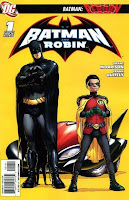 Batman and Robin (DC; 2 more issues)
Batman and Robin (DC; 2 more issues)This title was launched in 2009 as a new ongoing series dedicated to Grant Morrison’s multi-year, multi-title, multi-Batman epic run on the Batman franchise, and while it will technically continue publication once Morrison leaves it with November’s sixteenth issue for a new new Batman title, in effect Batman and Robin was just a maxi-series. (Sorry gang; that was a terribly written sentence. I have failed you, Brian Michael Bendis).
Like a lot—Most? All?—of the folks reading Batman and Robin, I was reading it because that’s just where Grant Morrison was doing his Batman writing at the time. Once he leaves it, I’ll leave it too.
Under normal circumstances, I would follow Morrison and his ongoing Bat-narrative into the next title hosting it, but that new title is going to experience a 33% price increase, which is just way too much for me to be able to spend on 22-pages of Batman comics…especially when I know if I simply wait a while, I’ll get a better value from the collections…or just be able to read it for free when a library purchases it and ads it to their collection.
Because I was only reading the book for the Morrison, naturally I won’t be buying #17 or any of the other issues that will follow, despite the fact that writer Peter J. Tomasi has written some pretty okay super-comics and the fact that artist Patrick Gleason is an incredible talent who I’m very happy to see getting such a fairly high-profile gig.
 Billy Batson and the Magic of Shazam! (DC; 2 more issues)
Billy Batson and the Magic of Shazam! (DC; 2 more issues) I was a big fan of this title’s original iteration—Mike Kunkel doing pretty much whatever he wants, at his own pace, following the continuity established in Jeff Smith’s Monster Society of Evil miniseries—but once DC decided to move the book into something approaching a regular schedule, it went through a rough period (issues of which I read rather randomly).
It didn’t really get it’s groove back until #13, when it finally got a stable creative team—Art Baltazar and Franco on script, Mike Norton doing some of the most impressive work of his career on pencils and inks—and now it’s been canceled, with next month’s #21 being the final issue.
I suppose there’s a chance some other version of the title will return in the near future, as several of DC’s kids comics were canceled only to be relaunched within a month or two, but, if not, this troubled title ultimately seems like an overall failure. Albeit one with some bright spots.
If you’ve never read any of it, I recommend Kunkel’s issues (#1-#4), the Stephen DeStephano-illustrated #6
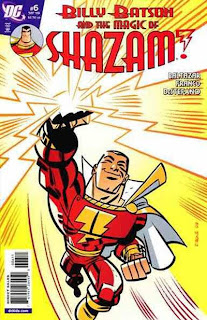 (You know what this world needs? More DeStephano-illustrated DC superhero comics…in the mean time, you guys should totally check out his Lucky In Love) and #17, the cows-that-get-abducted-by-aliens done-in-one issue.
(You know what this world needs? More DeStephano-illustrated DC superhero comics…in the mean time, you guys should totally check out his Lucky In Love) and #17, the cows-that-get-abducted-by-aliens done-in-one issue.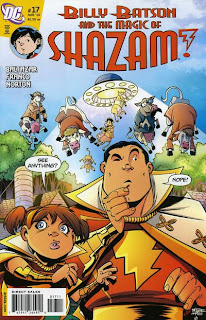 I’m sure a well-stocked back-issue bin will have most of those awfully cheap.
I’m sure a well-stocked back-issue bin will have most of those awfully cheap. 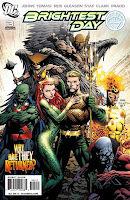 Brightest Day (DC; 15 more issues)
Brightest Day (DC; 15 more issues)I’m not entirely sure this belongs on the list, as it is a limited series, but it’s long enough a limited series that by the time it wraps up it will end up having more issues then plenty of ongoings that just don’t catch on in the market place, so what the hell—I’ll think of it as a canceled comic that just has plenty of issues to go.
This is a somewhat peculiar book for me, as there are things I really like about it and things I really don’t like about it, but the former outweigh the latter significantly enough that I keep reading.
In the plus column, the writing is generally pretty strong (albeit overly violent and faux-mature for my personal tastes), the cast is a big one full of diverse, lesser-known characters, it comes out bi-weekly, it stars a few of my favorite superhero characters, and some of the art is excellent.
In the minus column, the cover art is generally unimpressive-to-just plain awful, and some of the interior art makes me sick to look at (The Firestorm stuff, as I’ve mentioned before).
Because it’s pre-canceled at issue #26, I can’t imagine the few drawbacks will get enough traction to make me want to drop the book. Unless, I don’t know, we get four consecutive issues of the person who draws The Firestorms stuff drawing 22 pages of the evil martian character slaughtering children or something like that.
 Green Lantern (DC)
Green Lantern (DC) If you’ve read this blog very long, you probably know I have somewhat mixed feelings about Geoff Johns’ writing, but whether I always like what he does or not, there’s no denying he’s very, very good at what he does.
And what he does is write very entertaining DC superhero comic books, and I think somewhere around the time of 52 his skills made a rather noticeable leap, either because he became one of DC’s only reliable hit-makers and was given freer reign from editorial than he had previously, or because his fellow 52 writers Greg Rucka, Mark Waid and Grant Morrison all became blood brothers, cutting their palms and shaking hands so their blood, and thus the comics writing skills that infused it, intermingled, making him four times the writer he was before or…I don’t know.
But he’s been doing really great stuff on his Green Lantern book, which, thanks to all this “War of Light”/Blackest Night/Brightest Day rainbow lantern business has somehow become DC’s flagship title.
I love the fact that a lot of his concepts on Green Lantern sound completely stupid in summary, but then play out kind of awesome…or, put slightly more maturely, are at once ridiculous and clever, depending on how you squint or what angle you look at them from. It’s like 3D comics writing—close one eye and you only see the big, dumb stuff through the red lens; close the other eye, and you see only the audacious and clever stuff through the green lens; but read with both eyes open through the glasses, and man, what a comic book!
I think I’ve mentioned my distaste for Hal Jordan as a character before—in the same way I might admire Batman or think Aquaman or Martian Manhunter are cool dudes I’d like to hang out with, Hal Jordan seems like a jerk I’d cross the street to avoid having to say hello to. But Johns has built an enjoyable superhero comic around this dim and loathsome (to me) character, and every couple of months I’ll notice the number on the cover of an issue of Green Lantern and think, “My God, I’ve been reading this for forty-six months now...!" (Or whatever number of months happens to correspond to the number of the cover when I do this).
The title has definitely benefited from the fact that the writer has been so dedicated to it, sticking around so long—and thus never providing me a good “jumping off point” the way the previously discussed Batman and Robin will shortly—and it’s been relatively blessed with plenty of decent-to-pretty great artists (Carlos Pacheco, Ethan Van Sciver, Ivan Reis, Mike McKone).
In 57 issues, I’ve considered dropping the book just three times—during Daniel Acuna’s two-issue stint (#19-#20), during Philip Tan’s “Orange Lantern” story arc (#39-#42 and the complete mess of #49. But in each case, it was clear the artist whose style and/or skill I didn’t care for wasn’t going to be around long.
The current artist, Doug Mahnke, is one of my favorites to have drawn superheroes for DC on a regular basis in the last 20 years or so, so I don’t plan to drop this book any time soon.
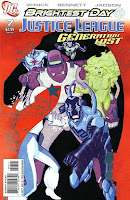 Justice League: Generation Lost (DC; 1-16 more issues)
Justice League: Generation Lost (DC; 1-16 more issues) As with Brightest Day, this is a 26-issue, every-other-weekly limited series, and thus maybe doesn’t belong here.
Unlike Brightest Day, I like the artwork a little less (the former book has different artists for different character storylines, whereas JL:GL switches artists every few issues, so if you don’t like one of the…three, I think it is, then you won’t like 22 out of every 66 pages) and have much, much, much, much less confidence in the writer (Judd Winick, working solo).
So I’ve been cautiously reading this, expecting something Judd Winick-y to happen at any moment and make me drop it. At this point, ten issues in, I’m probably safe, but I continue to buy it off the rack, rather than have my local-est comic shop add it to my pull-list.
I have a hard time recommending this book to people, given how damn specific the target audience seems to be, but I’m part of that target audience, so as long as it remains not-terrible, I’ll probably finish it up.
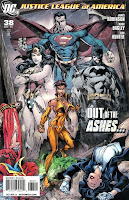 Justice League of America (DC)
Justice League of America (DC) Theoretically, this is perhaps my favorite superhero comic. That is, it was my favorite superhero comic at several points in the past, it easily could be, and I, personally, think it always should be.
I had been reading various DCU super-comics for a few years before the Morrison/Porter/Dell team launched JLA in 1997, and their run remains one of my favorite on any superhero comic ever. Mark Waid took the torch from Morrison and performed admirably, although his run was somewhat ruined by Bryan Hitch, who seemed unable to deliver 22-pages of pencil art on a monthly basis. The unlikely team of Joe Kelly, Doug Mahnke and Tom Nguyen that followed Waid and company also did a great job and then, as I mentioned the other day, the title sort of went off the tracks in 2004…and never really got back on the tracks (the seem to be getting there now though!)
That was the year when the “big” events of the DCU started to occur outside of JLA, and as more and more “evergreen” stories by rotating creative teams got dusted off and run in JLA, the title increasingly had less and less to do with the DCU…the characters were still being used in big, exciting stories, but those stories didn’t happen here anymore, and these stories didn’t reflect, let alone acknowledge those.
You know, the Denny O’Neil/Tan Eng Huat three-parter, the six-part John Byrne/Chris Claremont Doom Patrol reboot, the six-part Chuck Austen/Ron Garney cry-a-thon, the eight-part Kurt Busiek-written Crime Syndicate story (which should have been the start of a new ongoing run), and then a pair of stories that finally brought JLA into the goings on of the rest of the DCU, and also ended the series (the Geoff Johns/Allan Heinberg/Chris Batista Identity Crisis follow-up and the Bob Harras-scripted Infinite Crisis story arc where everyone quits the League…like a bunch of quitters).
The current volume started rough and never really got its act together, for reasons that the publisher never made clear (not that they would say, “Holy crap readers! You wouldn’t believe how screwed up things are on our end!”) but the final product couldn’t quite conceal either. (Good places to start, however, might be with a “regular” penciler unable to keep the 22-pages-a-month schedule, a “regular” writer who signed up for one, open-ended story arc, too much editorial interference and too many attempts to tie-in too rigidly to not-very-good crossovers and, in one bizarre case, to tie-in to a tie-in).
I had dropped the book about halfway through the Brad Meltzer/Ed Benes run, tried an issue here or there since, and eventually caught up in library trade, resuming purchasing a Justice League comic monthly only when James Robinson and Mark Bagley took over late last year.
Initially, the book seemed to suffer from the same weird interference that hurt previous regular writer Dwayne McDuffie’s run, with most of the Justice League members being unusable, and even the minor, B-, C- and D-List characters he brought into the fold disappearing just as suddenly (I’m still confused as to why a few issues were spent introducing Hal Jordan, Oliver Queen, Ray Palmer, Cyborg, The Guardian, Dr. Light, Mon-El and Starfire to the team if all of ‘em were going to be yanked from the line-up for various reasons in an issue or two anyway, for example).
But while characters were joining and quitting month-to-month and crossovers were being crossed in and out of (Robinson’s second and third issues on the title were Blackest Night tie-ins, his sixth was par of a “Rise and Fall”-branded story, and everything that followed has had “Brightest Day” across the top, although “Brightest Day” seems to be more of a branding efforts-style crossover than a read-every-chapter-to-follow-a-long sort of thing), at least Robinson now had Mark Bagley working with him.
If the book wasn’t always completely consistent in terms of characters and storyline, at least it always looked consistent, and thus felt consistent.
That’s certainly a step in the right direction.
Robinson struck me as something of a weird choice for the title, since so much of his best (Starman) and worst (Cry For Justice) DC super-writing has been ensemble books with the license to plunder DC’s intellectual property.
There’s an awful lot I haven’t enjoyed about Robinson’s run, much of it dealing with what strikes me as an inappropriate amount of gore, violence and emotional trauma, all of which seems far removed from what I personally want from a Justice League comic (plot-wise, what we got from the first ninety-some issues of JLA, or the original JLoA comics you find in Showcase Presents collections), and, of course, the Meltzer-like technique of over-narrating stories through color-coded narration boxes, which is essentially just a weird, visually busy way of writing Chris Claremont-style thought balloon-athons.
On the other hand, I am reading JLoA again. I considered dropping it during the JSA crossover, but my local comic shop had accidentally added it to my pull-list, and I didn’t hate it enough to take it off…even though I skipped the JSoA chapters. Ten issues seems like an awful long time to get the book moving in the direction a particular creative team might want, but then, JLoA has been fighting its way through crossovers, and it looks like it’s finally out of the woods.
So it looks like JLoA is about to start for real.
The writing is back to being strong, stronger it’s been on a regular basis since Kelly’s run ended (I think a Busiek run probably woulda kicked ass, but sadly, wasn’t in the in the cards), and the art’s not only good again, but consistent again, so if Robinson and Bagley can get at least enough leeway to keep a core cast for a couple of story arcs and be able to go in their own direction for a while instead of ping-ponging around crossovers, I’m actually looking forward to the future of this book.
And even if they can’t, I’m having a hard time imagining dropping it. With this particular creative team, I imagine Robinson’s tendency to pull in obscure DCU characters and concepts and Mark Bagley’s tendency to draw really awesome super-comics will make this a most-superheroes-per-comic value going forward (And once Brightest Day, Superman’s walk, Batman’s death and Wonder Woman’s continuity shenanigans are all over, the big seven are all gonna get back together at some point, right?)
Sorry, I went on way too long there. I just really like the Justice League!
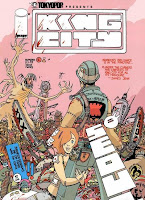 King City (Image Comics)
King City (Image Comics)I’ve been a huge fan of Brandon Graham’s ever since I first encountered his work, in 2005 Alternative Comics collection Escalator, and I’ve only come to admire his work (and work ethic!) more the more of it I’ve seen (although I do wish I could unsee some of the stuff I’ve seen in his porn comic Pillow Fight).
This Image Comic provides a consistent dose of Graham’s work, and also perhaps the best value you can find in a comic book-comic book at the moment. It’s an oversized 7-and-a-half-inch-by-10-and-just-a-smidge-under-a-half-inch, 32-page comic book featuring zero-to-one ads, front and back covers and occasional guest strips. Graham writes, draws, letters and often provides the covers himself, making it the most Graham-tastic book imaginable.
And it’s a buck cheaper than Time Masters: Vanishing Point or Ultimate Avengers 2.
I might never get over that fact.
Anyway, I’ve no intention of dropping this (and there’s a good chance it would be the very last serial comic I’d stop buying if I had to keep dropping comic book-comic books for any reason), and as far as I know Graham doesn’t plan to stop making it and Image doesn’t plan to stop publishing at any point in the foreseeable future.*
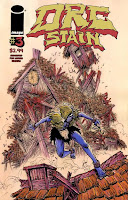 Orc Stain (Image)
Orc Stain (Image)James Stokoe’s fantasy series about the least scummy orc in a world full of scummy orcs is so far rather slight in terms of plot, and maybe not the best comic to look for great truths about the human experience or moving character drama, but good God is it a wonder to behold, well worth the price of admission to marvel at Stokoe’s detailed, imaginative, brilliantly-colored art work and the weird world he’s been gradually building with every line he draws.
There’s a good chance I would have trade-waited this book, had I not already known who Stokoe was (thanks to his pretty awesome Won Ton Soup digest from Oni Press) and had I not been the sort of nerd whose ears perk up at the mention of the word “orc.” I’m glad I got in on the ground floor though, as I like reading serial comic books in the comic book-comic book format, and this is a good one.
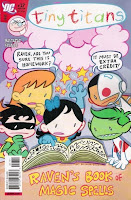 Tiny Titans (DC)
Tiny Titans (DC) I remember being extremely skeptical of this book when it was first announced—the whole Johnny DC line at the time, actually—and reading the first issue and feeling weird about the first experience. On the one hand, it was clearly intended for kids, but on the other hand, it featured obscure characters from the Marv Wolfman/George Perez run on the Titans franchise. Like, I’m not really sure I can explain Jericho and his powers or Trigon and Raven; I had a hard time imagining actual kids wanting to read about these guys.
The book won me over pretty quickly though, and there was a period where I’d be like, “Okay, one more issue…” since they were pretty formulaic and all, but then the next month in the shop I’d flip through the issue and see something like, I don’t know, the Tiny Titans version of Barda or Art Baltazar’s Alfred or something, and I couldn’t help but buy it.
Now it’s one of my favorite Big Two comics, and one of the last six DC comics on my pull-list. I’m not sure if I simply came around, or if Baltazar and co-writer Franco just got sharper and sharper with their work on the series as they found their groove, but I suspect it’s a bit of both.
I do know I had read a lot of John Stanley kids comics between the time I read Tiny Titans #1 and now, and that might have had something to do with it—now I recognize Tiny Titans as a Stanley-style gag comic for kids, only featuring cuter, brighter artwork and loads of DC Universe in-jokes.
I have no intention of dropping it, despite a modest, forty-four-cent price increase and a switch to a new slick and glossy paper stock, which I hate (The old paper stock was actually one of the many things I liked about Tiny Titans).
Looking ahead, the only books I seem to be adding are one-shots, miniseries and a random issue of a title here or there…with the likely exception of The All-New Batman: The Brave and The Bold, which, unlike the previous iteration of the title, will have a regular creative team.
So my regular purchases of ongoing-ish comic book-comic books—the ones publishers can rely on me buying month in and month out–amount to, as of September of this year, nine books.
By the end of the year, that will be down to seven, and if I add that A-NB:TbatB book, we’re back up to eight. But in another few months when limited series Justice League: Generation Lost an Brightest Day end, I’ll be down to just five.
That is not very many comic books at all.
SonDC can count on me definitely spending only $9 to $12 on their comic books month in and month out, Marvel can count on me definitely spending zero dollars each month and Image can count on me definitely spending $6 on their books per month.
I’ll likely spend a lot more on each company’s wares, and those of plenty of other publishers, but not with any rhyme or reason that the publishers (and, unfortunately, the retailers) will be able to predict.
What if there are 100 Calebs out there right now with similar buying habits? What if there are 1,000? That would be pretty bad, right?
*Actually, my comments section informs me that the book will end with #12, which will be very sad; it also informs me that Graham will move on to a Multiple Warheads comic, which will be fantastic—I really like that lady's hair

7 comments:
Actually, King City ends with issue #12, which is called the final issue in the solicits and I believe it was always intended to end there. I can't remember if issues #7-12 were material Tokyopop never got around to releasing or if it is new stuff Graham came up with since then though.
Also, Wonton Soup was from Oni, King City was from Tokyopop.
King City #7-12 was indeed meant as the second digest which finishes the story. But he is supposed to move onto a book called Multiple Warheads(which was a one-shot Oni released a few years back but will be released through Image).
http://www.comicbookresources.com/?page=article&id=21288
I agree with your impressions of Green Lantern. I'm shocked that a book that's featured a boring lead character for 57 issues could still be so entertaining. I surely consider that a flaw, and yet I also consider it an amazing phenomenon to achieve such an effect. "Yeah, the character blows, but it's a great comic!"
"As with Brightest Day, this is a 260-issue, every-other-weekly limited series, and thus maybe doesn’t belong here."
Watch that typo. I didn't know this was a ten-year maxiseries. =)
"I have failed you, Brian Michael Bendis"
Love this new internet joke lately :P
Thanks for the info and the typo-spotting, guys; I think I made the necessary corrections.
It sucks when the comics you know you love simply don't make it anymore for you. I was reading JLA too, up to the 20th something issue, where it became painful to keep reading.
And I had it worse with Teen Titans.
Can't say I get you sometimes Caleb, I mean you say Tomasi is a decent writer and that Gleason does some great art, but you still won't buy something they collaborate on? I mean that's all fine and good, no one's got a gun to your head, but if you're of the opinion that your pull list is constantly diminishing it's a little weird that you're so willing to shut yourself off to so some decidedly solid stuff.
Post a Comment